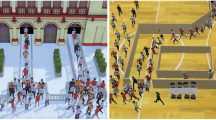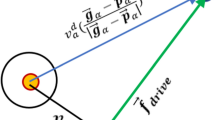Abstract
This paper proposes a rule-based motion planning system for agent-based crowd simulation, consisting of sets of rules for both collision avoidance and collision response. In order to avoid an oncoming collision, a set of rules for velocity sampling and evaluation is proposed, which aims to choose a velocity with an expected time to collision larger than a predefined threshold. In order to improve the efficiency over existing methods, the sampling procedure terminates upon finding an appropriate velocity. Moreover, the proposed motion planning system does not guarantee a collision-free movement. In case of collision, another set of rules is also defined to direct the agent to make a corresponding response. The experiment results show that the proposed approach can be applied in different scenarios, while making the simulation execution efficient.
Similar content being viewed by others
References
http://www.cs.unc.edu/~geom/RVO/Library/ (Accessed December 2009)
Abe, Y., Yoshiki, M.: Collision avoidance method for multiple autonomous mobile agents by implicit cooperation. In: Proceedings of 2001 IEEE/RSJ International Conference on Intelligent Robots and Systems, pp. 1207–1212 (2001)
van den Berg, J., Lin, M., Manocha, D.: Reciprocal velocity obstacles for real-time multi-agent navigation. In: Proceedings of IEEE International Conference on Robotics and Automation, pp. 1928–1935 (2008)
van den Berg, J., Overmars, M.: Planning time-minimal safe paths amidst unpredictably moving obstacles. Int. J. Robotics Res. 27(11–12), 1274–1294 (2008)
van den Berg, J., Patil, S., Sewall, J., Manocha, D., Lin, M.: Interactive navigation of individual agents in crowded environments. In: Proceedings of Symposium on Interactive 3D Graphics and Games (I3D’08), pp. 139–147 (2008)
Boris, K., Erwin, P.: Reflective navigation: Individual behaviors and: group behaviors. In: Proceedings of 2004 IEEE International Conference on Robotics and Automation, pp. 4172–4177 (2004)
Feurtey, F.: Simulating the collision avoidance behavior of pedestrians. Master’s thesis, University of Tokyo (2000)
Fiorini, P., Shiller, Z.: Motion planning in dynamic environments using velocity obstacles. Int. J. Robotics Res. 17(7), 23–33 (1998)
Fox, D., Burgard, W., Thrun, S.: The dynamic window approach to collision avoidance. IEEE Robotics Autom. Mag. 4(1), 23–33 (1997)
Gayle, R., Sud, A., Lin, M., Manocha, D.: Reactive deforming roadmaps: Motion planning of multiple robots in dynamic environments. Int. J. Robotics Res. 21(3), 233–255 (2002)
Helbing, D., Farkás, I.J., Molnár, P., Vicsek, T.: Simulation of pedestrian crowds in normal and evacuation situations. In: Schreckenberg, M., Sharma, S.D. (eds.) Pedestrian and Evacuation Dynamics, pp. 21–58. Springer, Berlin (2002)
Hsu, D., Kindel, R., Latombe, J.C., Rock, S.: Randomized kinodynamic motion planning with moving obstacles. Int. J. Robotics Res. 21(3), 233–255 (2002)
Hughes, R.: A continuum theory for the flow of pedestrians. Transp. Res. Part B 36(6), 507–535 (2002)
Jaillet, L., Simeon, T.: A PRM-based motion planner for dynamically changing environments. In: Proceedings of IEEE/RSJ Int. Conference on Intelligent Robots and Systems, pp. 1606–1611 (2004)
Li, Y., Gupta, K.: Motion planning of multiple agents in virtual environments on parallel architectures. In: Proceedings of IEEE International Conference on Robotics and Automation, pp. 1009–1014 (2007)
Mazarakis, G.P., Avaritsiotis, J.N.: A prototype sensor node for footstep detection. In: Wireless Sensor Networks, 2005. Proceedings of the Second European Workshop, pp. 415–418 (2005)
Nguyen, Q.H., McKenzie, F.D., Petty, M.D.: Crowd behavior cognitive model architecture design. In: Proceedings of the 2005 Behavior Representation in Modeling and Simulation (BRIMS) Conference, pp. 55–64. Universal City, CA (2005)
Parisi, D.R., Dorso, C.O.: Why faster is slower in evacuation process. In: Waldau, N., Gattermann, P., Knoflacher, H., Schreckenberg, M. (eds.) Pedestrian and Evacuation Dynamics 2005, pp. 341–346 (2007)
Pelechano, N., Allbeck, J., Badler, N.: Controlling individual agents in high-density crowd simulation. In: ACM SIGGRAPH/Eurographics Symposium on Computer Animation (SCA’07), pp. 99–108 (2007)
Pelechano, N., Allbeck, J., Badler, N.I.: Virtual Crowds: Methods, Simulation, and Control. Morgan & Claypool (2008)
Pelechano, N., O’Brien, K., Silverman, B., Badler, N.: Crowd simulation incorporating agent psychological models, roles and communication. In: Proceedings of the First International Workshop on Crowd Simulation. EPFL, Lausanne, Switzerland (2005)
Shiller, Z., Large, F., Sekhavat, S.: Motion planning in dynamic environments: Obstacles moving along arbitrary trajectories. In: Proceedings of IEEE International Conference on Robotics and Automation, vol. 4, pp. 3716–3721 (2001)
Stephen, C.: Flow tiles. In: Proceedings of the 2004 ACM SIGGRAPH/Eurographics symposium on Computer Animation, pp. 233–242. San Diego, California, USA (2004)
Sud, A., Andersen, E., Curtis, S., Lin, M., Manocha, D.: Real-time path planning for virtual agents in dynamic environments. In: Proceedings of IEEE Virtual Reality, pp. 91–98 (2007)
Thalmann, D., Musse, S.: Crowd Simulation. Springer, Berlin (2007)
Treuille, A., Cooper, S., Popović, Z.: Continuum crowds. In: Proceedings of ACM SIGGRAPH, pp. 1160–1168 (2006)
Weng, W., Pan, L., Shen, S., Yuan, H.: Small-grid analysis of discrete model for evacuation from a hall. Phys. A: Stat. Mech. Appl. 374(2), 821–826 (2007)
Xiong, M., Lees, M., Cai, W., Zhou, S., Low, M.Y.H.: A rule-based motion planning for crowd simulation. In: 2009 International Conference on CyberWorlds, pp. 88–95 (2009)
Author information
Authors and Affiliations
Corresponding author
Additional information
This paper is an extended version of our paper titled “A Rule-Based Motion Planning for Crowd Simulation” that appeared in the proceedings of 2009 International Conference on Cyberworlds (Cyberworlds 2009), pp. 88–95.
Rights and permissions
About this article
Cite this article
Xiong, M., Lees, M., Cai, W. et al. Analysis of an efficient rule-based motion planning system for simulating human crowds. Vis Comput 26, 367–383 (2010). https://doi.org/10.1007/s00371-010-0421-6
Published:
Issue Date:
DOI: https://doi.org/10.1007/s00371-010-0421-6




